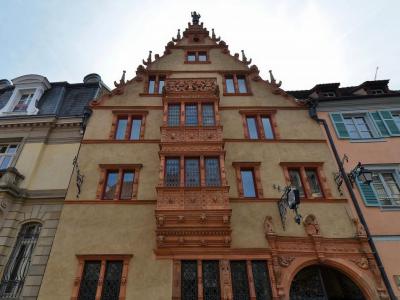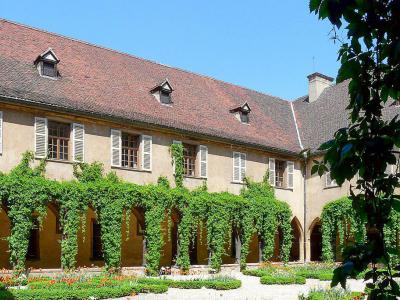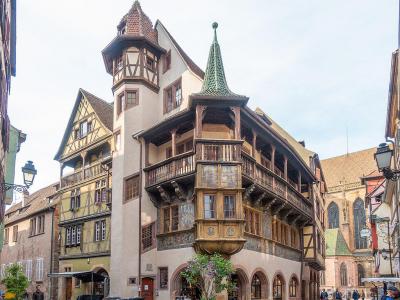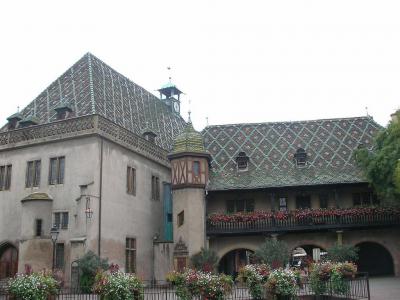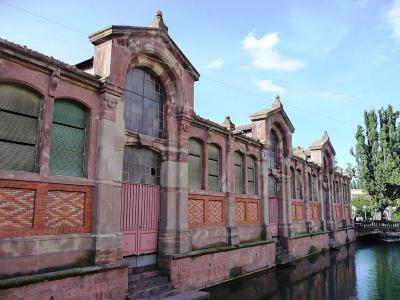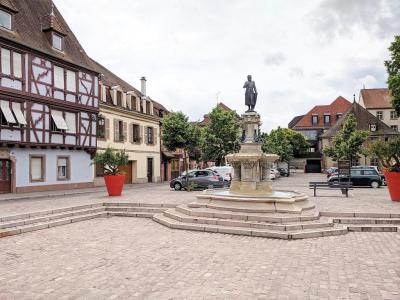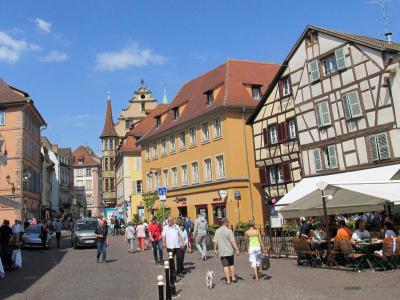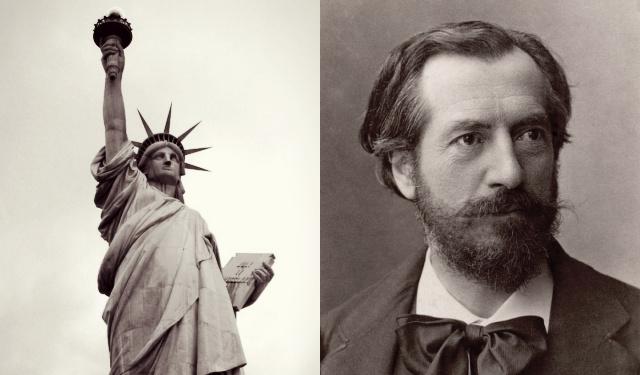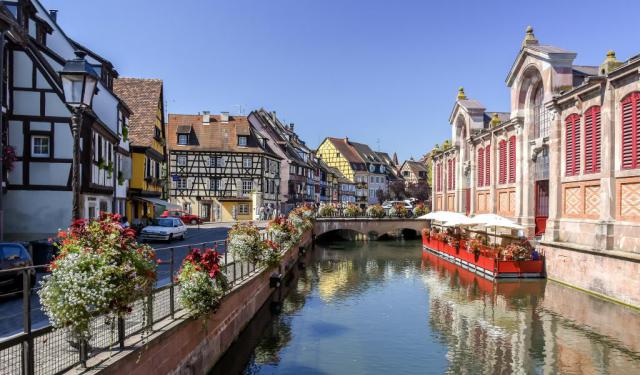
Colmar Introduction Walking Tour (Self Guided), Colmar
Charlemagne was well acquainted with Colmar in his wars with the Saxons from 772 to 804 AD. Carolingian emperor Charles the Fat held an assembly there in 884. It was a free imperial city under Emperor Frederick II in 1226. Captured and held by Sweden in 1632, it was conquered at last by Louis XIV of France in 1673.
In 1871 it was annexed by the German Empire as a result of the Franco-Prussian War and became a city of the Alsace-Lorraine province. Since then, it had been a prize fought over by the French and Germans until finally becoming French in 1945. Miraculously, the town was spared the ravages of the French Revolution, the Franco-Prussian War, and World Wars I and II.
The old-town section is a locale favored by international tourists. Canals of the river Lauch so crisscross the city that it is called "Little Venice." Landmarks show eight centuries of French and German influence. Buildings of pink and yellow Vosges sandstone and timber framing are everywhere.
The 13-century St. Martin Church is the largest church of Colmar. The Dominican Church, completed in 1364, is no longer used as a church, and today it houses French engraver and painter Martin Schongauer's masterpiece, The Virgin of the Rose Bush (La Vierge au buisson de roses). Gothic-Renaissance Saint Mathew Church and the Convent of the Antoines are ornate, 13th-century treasures.
Well-known Monuments include the Monument of General Rapp, a heroic Marshal of Napoleon, Monument Hirn, and a replica of the Statue of Liberty by Frederic Bartholdi. Bartholdi is also responsible for the fountains of Amiral Bruat, Roeselmann, and Schwendi.
The Unterlinden Museum is home to medieval, baroque, and Renaissance masterpieces. Bartholdi Museum is the birthplace of the great sculptor who designed the Statue of Liberty. Since 1980 Colmar has been home to the Colmar Festival, an international summer festival of classical music. Colmar is the inspiration for the anime films, "Howl's Moving Castle" and "Is the Order a Rabbit?"
Colmar is a not-to-miss location on the Alsace wine route. It is surrounded by extensive, charming countryside and the neighboring Vosges Mountains. Canals, mountains, the Middle Ages (without wars and plagues), classical music, and the finest wines of Alsace await. Don't miss out.
In 1871 it was annexed by the German Empire as a result of the Franco-Prussian War and became a city of the Alsace-Lorraine province. Since then, it had been a prize fought over by the French and Germans until finally becoming French in 1945. Miraculously, the town was spared the ravages of the French Revolution, the Franco-Prussian War, and World Wars I and II.
The old-town section is a locale favored by international tourists. Canals of the river Lauch so crisscross the city that it is called "Little Venice." Landmarks show eight centuries of French and German influence. Buildings of pink and yellow Vosges sandstone and timber framing are everywhere.
The 13-century St. Martin Church is the largest church of Colmar. The Dominican Church, completed in 1364, is no longer used as a church, and today it houses French engraver and painter Martin Schongauer's masterpiece, The Virgin of the Rose Bush (La Vierge au buisson de roses). Gothic-Renaissance Saint Mathew Church and the Convent of the Antoines are ornate, 13th-century treasures.
Well-known Monuments include the Monument of General Rapp, a heroic Marshal of Napoleon, Monument Hirn, and a replica of the Statue of Liberty by Frederic Bartholdi. Bartholdi is also responsible for the fountains of Amiral Bruat, Roeselmann, and Schwendi.
The Unterlinden Museum is home to medieval, baroque, and Renaissance masterpieces. Bartholdi Museum is the birthplace of the great sculptor who designed the Statue of Liberty. Since 1980 Colmar has been home to the Colmar Festival, an international summer festival of classical music. Colmar is the inspiration for the anime films, "Howl's Moving Castle" and "Is the Order a Rabbit?"
Colmar is a not-to-miss location on the Alsace wine route. It is surrounded by extensive, charming countryside and the neighboring Vosges Mountains. Canals, mountains, the Middle Ages (without wars and plagues), classical music, and the finest wines of Alsace await. Don't miss out.
How it works: Download the app "GPSmyCity: Walks in 1K+ Cities" from Apple App Store or Google Play Store to your mobile phone or tablet. The app turns your mobile device into a personal tour guide and its built-in GPS navigation functions guide you from one tour stop to next. The app works offline, so no data plan is needed when traveling abroad.
Colmar Introduction Walking Tour Map
Guide Name: Colmar Introduction Walking Tour
Guide Location: France » Colmar (See other walking tours in Colmar)
Guide Type: Self-guided Walking Tour (Sightseeing)
# of Attractions: 11
Tour Duration: 1 Hour(s)
Travel Distance: 1.5 Km or 0.9 Miles
Author: nataly
Sight(s) Featured in This Guide:
Guide Location: France » Colmar (See other walking tours in Colmar)
Guide Type: Self-guided Walking Tour (Sightseeing)
# of Attractions: 11
Tour Duration: 1 Hour(s)
Travel Distance: 1.5 Km or 0.9 Miles
Author: nataly
Sight(s) Featured in This Guide:
- Musee Unterlinden (Unterlinden Museum)
- Maison des Tetes (House of Heads)
- Couvent des Dominicains de Colmar (Dominican Church)
- Eglise Saint-Martin (St. Martin Church)
- Place de la Cathédrale (Cathedral Square)
- Maison Pfister (Pfister House)
- Ancienne Douane (Old Custom House)
- Marche Couvert (Covered Market)
- Little Venice and Fishmongers’ Wharf
- Place des Six Montagnes Noires (Square of the Six Black Mountains)
- Grand Rue (High Street)
1) Musee Unterlinden (Unterlinden Museum) (must see)
Matthias Grunewald was a painter of the German Renaissance. Only ten of his paintings and thirty-five drawings survived. The rest of his work was lost at sea while carried off by the Swedish army as booty. His masterpiece, the Isenheim Altarpiece of 1516, was spared. It has found a forever home in the Unterlinden Museum of Colmar (Musee Unterlinden), Alsace.
The museum, established in 1849, is housed in a 13th-century Dominican convent and a former public bath built in 1906. The convent, abandoned after the French Revolution, was saved by the Schongauer Society in 1847. Today, it is a French Museum visited by 200,000 visitors a year. It is one of the most well-known museums in Alsace.
In the beginning, the Unterlinden Museum's collection featured Roman mosaics discovered in Bergheim and sculptures loaned by the Louvre. In 1852 Grunewald's Altarpiece arrived. The altarpiece, along with other painted and sculpted altarpieces from Rhenish churches, abbeys, and monasteries, was installed in the old convent. The museum opened in 1853.
The need for more space appeared as the museum collections expanded significantly in the 1950s and 1980s. The city of Colmar added the nearby Neo-Baroque public bath building as a museum annex in 2015. The total area open to the public is 86,000 square feet.
The museum houses a considerable collection of Rhenish medieval and Renaissance art, including its crown jewel, Grunewald's Altarpiece. Martin Schongauer, a notable engraver and painter, is represented by altarpieces, drawings, engravings, and woodcuts. Other names are Albrecht Durer, Lucas Cranach, Hans Holbein, Caspar Isenmann, Jost Haller and Wilhelm Stetter.
Anonymous early German, Alsation, and Swiss masters, especially the Master of the Stauffenberg Altarpiece, are represented. Some sections of the museum are dedicated to archeology, Medieval, Baroque, and Renaissance sculpture, stained glass, weapons, music, and toys. Further expansion is contemplated.
The museum, established in 1849, is housed in a 13th-century Dominican convent and a former public bath built in 1906. The convent, abandoned after the French Revolution, was saved by the Schongauer Society in 1847. Today, it is a French Museum visited by 200,000 visitors a year. It is one of the most well-known museums in Alsace.
In the beginning, the Unterlinden Museum's collection featured Roman mosaics discovered in Bergheim and sculptures loaned by the Louvre. In 1852 Grunewald's Altarpiece arrived. The altarpiece, along with other painted and sculpted altarpieces from Rhenish churches, abbeys, and monasteries, was installed in the old convent. The museum opened in 1853.
The need for more space appeared as the museum collections expanded significantly in the 1950s and 1980s. The city of Colmar added the nearby Neo-Baroque public bath building as a museum annex in 2015. The total area open to the public is 86,000 square feet.
The museum houses a considerable collection of Rhenish medieval and Renaissance art, including its crown jewel, Grunewald's Altarpiece. Martin Schongauer, a notable engraver and painter, is represented by altarpieces, drawings, engravings, and woodcuts. Other names are Albrecht Durer, Lucas Cranach, Hans Holbein, Caspar Isenmann, Jost Haller and Wilhelm Stetter.
Anonymous early German, Alsation, and Swiss masters, especially the Master of the Stauffenberg Altarpiece, are represented. Some sections of the museum are dedicated to archeology, Medieval, Baroque, and Renaissance sculpture, stained glass, weapons, music, and toys. Further expansion is contemplated.
2) Maison des Tetes (House of Heads)
Anton Burger was a shopkeeper in the city of Colmar. He was born in 1579. He inherited his father's house and had it demolished in 1609. He built his own house on the property, which became the famous "House of the Heads."
The Maison des Tetes (House of Heads), designed by architect Albert Schmidt, features the German Renaissance style. The facade of the building shows two square floors with strips and three levels on the high gable. An oriel covers two stories in the center. It has an openwork stone railing adorned with bifurcated figures. The building gets its name from the 106 sculpted heads on the oriel and mullions of the windows.
Posing on the gable is the pewter statue of an Alsation cooper holding a wine bottle in his left hand and a stein in his right. Created by painter and sculptor Auguste Bartholdi in 1902, the statue marks the setting up of the Colmar Wine Exchange. Anton Burger lived in his house until he fled the Catholic Counter-Reformation. He settled in Basel in 1698, and he died there.
Burger's heirs sold the house in 1698. The building passed through the hands of several owners and was acquired by the Wine Exchange. The house became a restaurant and social watering hole since 1898.
Today the historical building houses a 5-star hotel and a Michelin-starred gourmet restaurant.
The Maison des Tetes (House of Heads), designed by architect Albert Schmidt, features the German Renaissance style. The facade of the building shows two square floors with strips and three levels on the high gable. An oriel covers two stories in the center. It has an openwork stone railing adorned with bifurcated figures. The building gets its name from the 106 sculpted heads on the oriel and mullions of the windows.
Posing on the gable is the pewter statue of an Alsation cooper holding a wine bottle in his left hand and a stein in his right. Created by painter and sculptor Auguste Bartholdi in 1902, the statue marks the setting up of the Colmar Wine Exchange. Anton Burger lived in his house until he fled the Catholic Counter-Reformation. He settled in Basel in 1698, and he died there.
Burger's heirs sold the house in 1698. The building passed through the hands of several owners and was acquired by the Wine Exchange. The house became a restaurant and social watering hole since 1898.
Today the historical building houses a 5-star hotel and a Michelin-starred gourmet restaurant.
3) Couvent des Dominicains de Colmar (Dominican Church)
Also called the Dominican Church, the convent is located at the Dominican Square (Place des Dominicains) and Nr. 1 Martyrs-of-the-Resistance Square (Place des Martyrs-de-la-Resistance) in Colmar. Couvent des Dominicains de Colmar was built in 1289 by the Dominican mendicant order of Preachers. The Preachers had arrived in Colmar in 1260.
The church has a vaulted choir of five bays. It has an apse of five octagonal sides and a nave with six bays supported by slender columns without capitals. Its stained glass windows date from early in the 14th century. They depict scenes from the Life of Christ. The cloister has arcades established in an irregular rectangle.
The choir is earlier than 1300. The nave was completed in 1346. The "Virgin of the Rose Bush," an altarpiece painted in 1473 by Renaissance artist Martin Schongauer, is in the choir. Murals in the cloister, painted from the last days of the 15th century, show the Passion of Christ.
During the 19th century, the church served non-religious purposes. The church was used for military stores during the French Revolution. In 1807 it became a corn exchange. In 1898 it was returned as a place of worship.
The convent buildings were erected in 1300, rebuilt in the 18th century, transformed into barracks for the gendarmerie in 1795, then housed the preparatory school for teachers. Since 1951 they have accommodated the municipal library.
The cloister and the church have been classified as historical monuments since November 2, 1948.
The church has a vaulted choir of five bays. It has an apse of five octagonal sides and a nave with six bays supported by slender columns without capitals. Its stained glass windows date from early in the 14th century. They depict scenes from the Life of Christ. The cloister has arcades established in an irregular rectangle.
The choir is earlier than 1300. The nave was completed in 1346. The "Virgin of the Rose Bush," an altarpiece painted in 1473 by Renaissance artist Martin Schongauer, is in the choir. Murals in the cloister, painted from the last days of the 15th century, show the Passion of Christ.
During the 19th century, the church served non-religious purposes. The church was used for military stores during the French Revolution. In 1807 it became a corn exchange. In 1898 it was returned as a place of worship.
The convent buildings were erected in 1300, rebuilt in the 18th century, transformed into barracks for the gendarmerie in 1795, then housed the preparatory school for teachers. Since 1951 they have accommodated the municipal library.
The cloister and the church have been classified as historical monuments since November 2, 1948.
4) Eglise Saint-Martin (St. Martin Church) (must see)
In 1972, archeologists discovered the remains of two churches under the Saint Martin Church (Eglise Saint-Martin) in Colmar. The oldest was built in the Carolingian style and dated from about 1000 AD. The foundation of the second was a Romanesque-style church. The present Saint Martin Church was a collegiate church built between 1234 and 1365.
The total interior length of the Saint Martin Church is 256 feet, while the height is 66 feet. The transept measures 112 feet in width. The steeple is 233 feet high.
The collegiate church, long defunct, was dedicated to Saint Martin of Tours. The tall, square bell tower, topped with a "helmet" covering, was added in 1572 after a fire. Several undersized portals surround the church, and some have been bricked up. The largest have richly decorated tympanums. The roof is of colored tile.
The facade is supported by massive polygonal columns that give the front of the building a stolid effect, contrasting with the aspiring look of the high apse windows. The interior is spacious, featuring a Baroque organ case from 1755 and a traditional Alsatian ambulatory.
The chapels around the choir have Medieval altars and statues. Among the Gothic stained glass windows in the nave is one with a rare 13th-century depiction of a beardless Christ. In 1482, the artist Caspar Isenmann was commissioned to paint panels showing the Life of Jesus Christ. Seven surviving oil-on-wood works are exhibited in the Unterlinden Museum.
The people of Colmar consider the church to be their cathedral. However, it was a cathedral for only ten years in its history. That status was in effect only from the Civil Constitution of the Clergy in 1790 to the Concordat of 1801. The church is more of a collegiate-type church dedicated to Saint Martin.
The total interior length of the Saint Martin Church is 256 feet, while the height is 66 feet. The transept measures 112 feet in width. The steeple is 233 feet high.
The collegiate church, long defunct, was dedicated to Saint Martin of Tours. The tall, square bell tower, topped with a "helmet" covering, was added in 1572 after a fire. Several undersized portals surround the church, and some have been bricked up. The largest have richly decorated tympanums. The roof is of colored tile.
The facade is supported by massive polygonal columns that give the front of the building a stolid effect, contrasting with the aspiring look of the high apse windows. The interior is spacious, featuring a Baroque organ case from 1755 and a traditional Alsatian ambulatory.
The chapels around the choir have Medieval altars and statues. Among the Gothic stained glass windows in the nave is one with a rare 13th-century depiction of a beardless Christ. In 1482, the artist Caspar Isenmann was commissioned to paint panels showing the Life of Jesus Christ. Seven surviving oil-on-wood works are exhibited in the Unterlinden Museum.
The people of Colmar consider the church to be their cathedral. However, it was a cathedral for only ten years in its history. That status was in effect only from the Civil Constitution of the Clergy in 1790 to the Concordat of 1801. The church is more of a collegiate-type church dedicated to Saint Martin.
5) Place de la Cathédrale (Cathedral Square)
The name Cathedral Square (Place de la Cathedrale) is new. Until 1934, the 13th-century square was called New Square (Place Neuve), as it extended over the old cemetery of the Mount of Olives. Part of the cemetery was closed in 1553 to make room for a marketplace between the Saint-Martin Collegiate Church and the Ossuary (bone depository).
The Waldner-Stephan Court (Cour Waldner-Stephan) is a courtyard by Cathedral Square. It is home to the ancient Judas tree, planted in 1791. According to a legend, Judas hung himself on such a tree. It is said the purple blossoms symbolize the tears of Christ. The old tree is surrounded by an iron railing. A plaque cites the date of planting.
An important building on the square is the Guard House (Corps de Garde), based on the 1286 chapel of Saint James. It has a loggia and portal, installed in 1577, constituting a gem of Renaissance architecture. It has served as a town hall, guardhouse, nut market, platform for magistrates, and police station.
At 6 Cathedral Square is the RUC bookstore. It has over 45,000 references on five levels served by a large central staircase. The Adolph House, at number 16, is considered one of the oldest in Colmar, built around 1350. It has late 14th-century Gothic bays with pointed arch windows. Next to the Adolph House is an old well dating back to 1592.
At 11 Cathedral Square is Yann's Workshop (l'Atelier Yann), a vast patisserie. At the foot of the church is the brewery and brasserie, l'Amandine.
The Waldner-Stephan Court (Cour Waldner-Stephan) is a courtyard by Cathedral Square. It is home to the ancient Judas tree, planted in 1791. According to a legend, Judas hung himself on such a tree. It is said the purple blossoms symbolize the tears of Christ. The old tree is surrounded by an iron railing. A plaque cites the date of planting.
An important building on the square is the Guard House (Corps de Garde), based on the 1286 chapel of Saint James. It has a loggia and portal, installed in 1577, constituting a gem of Renaissance architecture. It has served as a town hall, guardhouse, nut market, platform for magistrates, and police station.
At 6 Cathedral Square is the RUC bookstore. It has over 45,000 references on five levels served by a large central staircase. The Adolph House, at number 16, is considered one of the oldest in Colmar, built around 1350. It has late 14th-century Gothic bays with pointed arch windows. Next to the Adolph House is an old well dating back to 1592.
At 11 Cathedral Square is Yann's Workshop (l'Atelier Yann), a vast patisserie. At the foot of the church is the brewery and brasserie, l'Amandine.
6) Maison Pfister (Pfister House) (must see)
Behind the Zum Kragen House at 11 Merchants Street (Rue des Marchands) is the Pfister House (Maison Pfister), often called "a real gem" from the Middle Ages. It is the most well-known house in Colmar. Built in 1537 for hatter Ludwig Scherer, it replaced a building sometimes called the "Red Rooster" or "the Black Hands."
From 1790 to 1830, it changed hands between haberdasher Charles Macker and merchant Francois Jean Pfister (hence its name today). Since 1892 it has been in the Judlin family of wholesalers who restored the Maison in 1909.
The Pfister House, made of Rouffach sandstone and wood, has a two-story corner bay window and turret. There are arched arcades on the ground floor and mullioned, triple-crossed windows on the other two stories. There are two attic levels. Underneath are curved stone Gothic ogives. On top of the oriel, which covers two floors, is a wood balustrade.
The house has a spiral staircase octagonal turret with a bulb crown. Paintings on the facade, credited to artist Christian Vacksterffer, depict Germanic emperors of the 16th century. Also represented are the escutcheons of Colmar and Haute-Alsace, the four Evangelists, the Western Church Fathers, and scenes from Genesis.
From 1790 to 1830, it changed hands between haberdasher Charles Macker and merchant Francois Jean Pfister (hence its name today). Since 1892 it has been in the Judlin family of wholesalers who restored the Maison in 1909.
The Pfister House, made of Rouffach sandstone and wood, has a two-story corner bay window and turret. There are arched arcades on the ground floor and mullioned, triple-crossed windows on the other two stories. There are two attic levels. Underneath are curved stone Gothic ogives. On top of the oriel, which covers two floors, is a wood balustrade.
The house has a spiral staircase octagonal turret with a bulb crown. Paintings on the facade, credited to artist Christian Vacksterffer, depict Germanic emperors of the 16th century. Also represented are the escutcheons of Colmar and Haute-Alsace, the four Evangelists, the Western Church Fathers, and scenes from Genesis.
7) Ancienne Douane (Old Custom House) (must see)
Also known as the Koifhus, the Old Custom House (Ancienne Douane) is located at the intersection of the two medieval roads of the city, High Street (Grand Rue) and Merchants Street (Rue des Marchands). The present building, planned in 1433, was not completed until 1480. Annexes and add-ons of the 16th century made the house precarious by the 19th century. Demolition was in order.
But restoration, from 1895 to 1898, happened instead. The turret and glazed tiles are from that time. In 2002, the old sandstone balustrade was restored. The building was used as a warehouse and as an import-export tax center. The Federation of the Ten Imperial Cities of Alsace of 1534 met there. After the French Revolution, change came.
Commercial privileges were abolished. In 1840 the building was home to a theatre. In 1848 it was the first office of the discount bank. The Koifhus housed the Chamber of Commerce and boys' schools until 1930. Today it is a venue for public activities and events.
Jean Rapp, a French general and consul during the Napoleonic Wars, was born in the Old Custom House. His father was a janitor there. Rapp was known for his daring in battle and his sense of honor. There is a plaque on the Old Custom House for him. A statue of Jean Rapp, made by sculptor Frédéric Auguste Bartholdi, stands in the Field of Mars Park (Parc Champ de Mars).
But restoration, from 1895 to 1898, happened instead. The turret and glazed tiles are from that time. In 2002, the old sandstone balustrade was restored. The building was used as a warehouse and as an import-export tax center. The Federation of the Ten Imperial Cities of Alsace of 1534 met there. After the French Revolution, change came.
Commercial privileges were abolished. In 1840 the building was home to a theatre. In 1848 it was the first office of the discount bank. The Koifhus housed the Chamber of Commerce and boys' schools until 1930. Today it is a venue for public activities and events.
Jean Rapp, a French general and consul during the Napoleonic Wars, was born in the Old Custom House. His father was a janitor there. Rapp was known for his daring in battle and his sense of honor. There is a plaque on the Old Custom House for him. A statue of Jean Rapp, made by sculptor Frédéric Auguste Bartholdi, stands in the Field of Mars Park (Parc Champ de Mars).
8) Marche Couvert (Covered Market) (must see)
The Covered Market of Colmar (Marche Couvert) is located in the heart of the "Little Venice" area of Colmar and the Fishmongers' District, where professional fishermen and boatmen of Colmar lived once. It has cheeses, quiche, fish, meats, Vietnamese and Moroccan cuisine, coffee, cakes, and a patio overlooking the water. Yes, something for everyone, including wine and box lunches.
The Covered Market was built in the 19th century by architect Louis-Michel Boltz. It is situated on the banks of the Lauch River that flows through Colmar. The waters of the river border the marketplace as a moat borders a castle. Market gardeners unloaded produce from their flat-bottomed boats directly at the river portals.
The Covered Market is made of brick and cut stone. The framework is metal, and it has cast-iron columns. On the southwest side stays the statue of The Little Wine Grower, sculpted by Auguste Bartholdi in 1869. The many market stalls inside the building create a lively ambiance.
Need a quick lunch? The Covered Market is home to several small restaurants, cafes, and bistros. L'Enfarine patisserie has baked goods; Saint-Nicolas Cheese Factory offers cheeses; Schmidt Farm sells foie gras; Lemon and Basil have snacks; and Cooked Raw (Cuit Lu Cru) serves a plant-based cuisine.
The Covered Market was built in the 19th century by architect Louis-Michel Boltz. It is situated on the banks of the Lauch River that flows through Colmar. The waters of the river border the marketplace as a moat borders a castle. Market gardeners unloaded produce from their flat-bottomed boats directly at the river portals.
The Covered Market is made of brick and cut stone. The framework is metal, and it has cast-iron columns. On the southwest side stays the statue of The Little Wine Grower, sculpted by Auguste Bartholdi in 1869. The many market stalls inside the building create a lively ambiance.
Need a quick lunch? The Covered Market is home to several small restaurants, cafes, and bistros. L'Enfarine patisserie has baked goods; Saint-Nicolas Cheese Factory offers cheeses; Schmidt Farm sells foie gras; Lemon and Basil have snacks; and Cooked Raw (Cuit Lu Cru) serves a plant-based cuisine.
9) Little Venice and Fishmongers’ Wharf (must see)
Colmar is at the heart of the Alsace Wine Route. The Little Venice (La Petite Venise) district of the old town lies along the banks of the Lauch River canal. The cobbled canal side road is lined with multi-colored half-timbered houses. In all honesty, "Little Bruges" or "Little Amsterdam" might be a more apt name for the district as it has but one river.
The Lauch River extends 45 kilometers from the Vosges Mountains. The most romantic way to enter the district is to purchase boat tickets at the pub where the flat-bottomed boats are moored. The boatman sculls the craft along the canal while relating some of the stories of Colmar.
A good walk starts at Old Custom Square (Place de l'Ancienne Douane). Pass by Auguste Bartholdi's statue of General Lazare de Schwendie. He poses in full 16th-century armor, looking like Don Quixote. Walk along the Street of the Tanners. Come to the Quay of the Fishshop (Quai de la Poissonerie) via a bridge over the Street of the Tanners.
The brightly colored half-timbered houses were the homes of the fishing guild. Here is the famed Covered Market of Colmar. The Street leads to Krutenau, the fruit, and vegetable market. It was once the village of the market gardeners. Over the Abreuvoir Bridge (Pont de l'Abreuvoir) and down the Herse Street (Rue de la Herse), turn right to la Little Venice.
There is a stunning view of the district from the Saint-Pierre Bridge. After the bridge, follow Saint-Pierre Boulevard to Manege Street (Rue du Manege). Make a right turn and arrive at the Square of the Six Black Mountains (Place des Six-Montagnes-Noires).
The Lauch River extends 45 kilometers from the Vosges Mountains. The most romantic way to enter the district is to purchase boat tickets at the pub where the flat-bottomed boats are moored. The boatman sculls the craft along the canal while relating some of the stories of Colmar.
A good walk starts at Old Custom Square (Place de l'Ancienne Douane). Pass by Auguste Bartholdi's statue of General Lazare de Schwendie. He poses in full 16th-century armor, looking like Don Quixote. Walk along the Street of the Tanners. Come to the Quay of the Fishshop (Quai de la Poissonerie) via a bridge over the Street of the Tanners.
The brightly colored half-timbered houses were the homes of the fishing guild. Here is the famed Covered Market of Colmar. The Street leads to Krutenau, the fruit, and vegetable market. It was once the village of the market gardeners. Over the Abreuvoir Bridge (Pont de l'Abreuvoir) and down the Herse Street (Rue de la Herse), turn right to la Little Venice.
There is a stunning view of the district from the Saint-Pierre Bridge. After the bridge, follow Saint-Pierre Boulevard to Manege Street (Rue du Manege). Make a right turn and arrive at the Square of the Six Black Mountains (Place des Six-Montagnes-Noires).
10) Place des Six Montagnes Noires (Square of the Six Black Mountains)
The Square of the Six Black Mountains (Place des Six Montagnes Noires) is on the site of the old "Zum Schwarzenberg," a highly popular up-scale 14th-century hostelry that burned down in 1880.
Many legendary personalities stayed there. The guest list included the princes of Wurttemberg, Duke Wellington, Field Marshal Gustav Horn (hero of the Thirty Years' War who strengthened France in Europe), Marshal General Turenne (who deprived Spain of domination in Europe), and even Cardinal Jules Mazarin.
The hotel burned down at the end of the 19th century. After the fire, the city of Colmar erected a fountain on the spot called the Roesselmann Fountain and therein lies a tale. The fountain features a bronze statue of Judge Jean Roesselmann, who died in 1262. He was defending the independence of Colmar against the bishop of Strasbourg.
The sculptor, Auguste Bartholdi, gave Roesselmann the features of Mayor Hercule de Payerimhoff, who was forced out of office by German occupiers in 1871. The fountain, adorned with four bronze fish weirs, was inspired by the multi-lobed form of Gothic-style fountains.
Square of the Six Black Mountains is one of the five Christmas markets in Colmar. It is reserved for the children's market. It has mini houses, a carousel, and Santa's great mailbox.
Many legendary personalities stayed there. The guest list included the princes of Wurttemberg, Duke Wellington, Field Marshal Gustav Horn (hero of the Thirty Years' War who strengthened France in Europe), Marshal General Turenne (who deprived Spain of domination in Europe), and even Cardinal Jules Mazarin.
The hotel burned down at the end of the 19th century. After the fire, the city of Colmar erected a fountain on the spot called the Roesselmann Fountain and therein lies a tale. The fountain features a bronze statue of Judge Jean Roesselmann, who died in 1262. He was defending the independence of Colmar against the bishop of Strasbourg.
The sculptor, Auguste Bartholdi, gave Roesselmann the features of Mayor Hercule de Payerimhoff, who was forced out of office by German occupiers in 1871. The fountain, adorned with four bronze fish weirs, was inspired by the multi-lobed form of Gothic-style fountains.
Square of the Six Black Mountains is one of the five Christmas markets in Colmar. It is reserved for the children's market. It has mini houses, a carousel, and Santa's great mailbox.
11) Grand Rue (High Street)
If it's your first time in Colmar, try a walking tour on the High Street (Grand Rue). The street leads past many captivating sights. For example, there will be the Customs House, the Church of St Mathew, Sandherr House, Kern House, the House of the St. John's Knights, the Roesselmann Fountain, and the Flower Market Square (Place du Marche aux Fleurs).
A little bit to the side of the street, one easily encounters the massive Collegiate Church of St Martin and the charming district of "Little Venice." It's ok to wander a bit. Getting "lost" in Old Colmar is not a bad idea. There are great shops, sights, and gourmet heaven.
The street is not very long, just over 1,600 feet. It begins in the Square of Six Black Mountains and ends in Joan of Arc Square. All along the way are restaurants, bars, cafes, beautiful medieval buildings, and shops.
A little bit to the side of the street, one easily encounters the massive Collegiate Church of St Martin and the charming district of "Little Venice." It's ok to wander a bit. Getting "lost" in Old Colmar is not a bad idea. There are great shops, sights, and gourmet heaven.
The street is not very long, just over 1,600 feet. It begins in the Square of Six Black Mountains and ends in Joan of Arc Square. All along the way are restaurants, bars, cafes, beautiful medieval buildings, and shops.
Walking Tours in Colmar, France
Create Your Own Walk in Colmar
Creating your own self-guided walk in Colmar is easy and fun. Choose the city attractions that you want to see and a walk route map will be created just for you. You can even set your hotel as the start point of the walk.
Bartholdi's Statues in Colmar
Auguste Bartholdi is one of the most famous artists from Colmar. His works, such as the Lion of Belfort in Belfort, France, and the Statue of Liberty in New York Harbor, are known around the world. Colmar is decorated with open-air pieces sculpted by the artist.
Many of Bartholdi's statues are found in fountains that occupy spaces in city squares or on significant street corners. Some of... view more
Tour Duration: 3 Hour(s)
Travel Distance: 5.9 Km or 3.7 Miles
Many of Bartholdi's statues are found in fountains that occupy spaces in city squares or on significant street corners. Some of... view more
Tour Duration: 3 Hour(s)
Travel Distance: 5.9 Km or 3.7 Miles
The Most Popular Cities
/ view all

